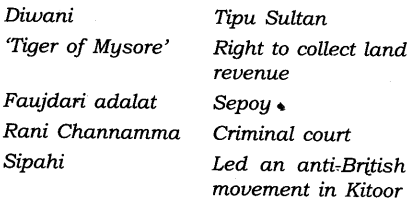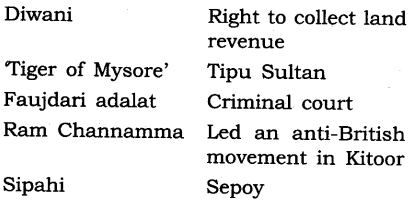Question 1.
Match the following:

Answer:

Question 2.
Fill in the blanks:
- The British conquest of Bengal began with the Battle of …………
- Haider Ali and Tipu Sultan were the rulers of …………..
- Dalhousie implemented the Doctrine of ……………
- Maratha kingdoms were located mainly in the part of …………… India.
Answer:
- Plassey
- Mysore
- Lapse
- Western
Question 3.
State whether true or false:
- The Mughal empire became stronger in the eighteenth century.
- The English East India Company was the only European company that traded with India.
- Maharaja Ranjit Singh was the ruler of Punjab.
- The British did not introduce administrative changes in the territories they conquered.
Answer:
- False
- False
- True
- False
Question 4.
What attracted European trading companies to India?
Answer:
- The fine qualities of cotton and silk produced in India.
- Indian spices such as pepper, cloves, cardamom, and cinnamon.
Question 5.
What were the areas of conflict between the Bengal Nawabs and the East India Company?
Answer:
- The Bengal nawabs asserted their power and autonomy and refused to grant the Company concessions,
- They demanded large tributes for the Company’s right to trade,
- They denied the Company any right to mint coins,
- They stopped the Company from extending its fortifications
- Accusing the Company of deceit, they claimed that the Company was depriving the Bengal government of huge amounts of revenue and undermining the authority of the nawab. It was refusing to pay taxes, writing disrespectful letters, and trying to humiliate the nawab and his officials. These were the areas of conflict between the Bengal Nawabs and the East India Company.
Question 6.
How did the assumption of Diwani benefit the East India Company?
Answer:
The Mughal emperor, in 1765, appointed the Company’s the Diwan of the provinces of Bengal. The Diwani allowed the Company to exploit the vast revenue resources of Bengal. This solved a major problem that the company had earlier faced. Although its trade had expanded, it had to buy most of the goods in India with gold and silver imported from Britain. The overflow of gold from Britain stopped after the assumption of Diwani. Now revenue from India could finance Company expenses. These revenues they used to purchase cotton and silk textiles in India, maintain Company troops and meet the cost of building the Company fort and offices at Calcutta.
Question 7.
Explain the system of ‘subsidiary alliance’.
Answer:
Under the system of ‘subsidiary alliance’, Indian rulers were not allowed to have their independent armed forces. They were to be protected by the Company, but had to pay for the ‘subsidiary forces’ that the Company was supposed to maintain for the purpose of this protection. If the Indian rulers failed to make the payment, the part of their territory was taken away as penalty. The states which had to lose their territories on this ground were Awadh and Hyderabad.